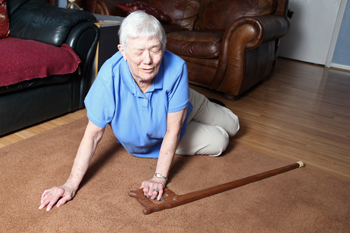Fall-associated injuries and death continue to be a problem among the elderly and, especially, among nursing home residents.
 Our long-term care customers are facing a $34 billion problem, according to the Centers for Disease Control and Prevention (CDC). In spite of increased attention to injuries and death associated with falls among people aged 65 and older, falls continue to be a problem – particularly for nursing home residents. About 1,800 older adults living in nursing homes die each year from fall-related injuries, and those who survive often sustain injuries resulting in permanent disability and reduced quality of life. Consider the following:
Our long-term care customers are facing a $34 billion problem, according to the Centers for Disease Control and Prevention (CDC). In spite of increased attention to injuries and death associated with falls among people aged 65 and older, falls continue to be a problem – particularly for nursing home residents. About 1,800 older adults living in nursing homes die each year from fall-related injuries, and those who survive often sustain injuries resulting in permanent disability and reduced quality of life. Consider the following:
- One in three adults aged 65 and older falls each year. Of these individuals, 20 to 30 percent suffer moderate to severe injuries that make it hard for them to get around or live independently, and increase their risk of early death.
- Older adults are hospitalized for fall-related injuries five times more often than they are for injuries from other causes.
- Emergency departments treat about 2.5 million nonfatal fall injuries among older adults each year. Of these patients, about 734,000 must be hospitalized.
- More than 1.4 million people 65 and older live in nursing homes.
- Each year, a typical nursing home with 100 beds reports 100 to 200 falls. (Many falls go unreported.)
- Between half and three-quarters of nursing home residents fall each year.
- About 1,800 people living in nursing homes die from falls each year.
- About 10 to 20 percent of nursing home falls cause serious injuries, while 2 to 6 percent cause fractures.
Falls result in disability, functional decline and reduced quality of life, and a fear of falling can cause further loss of function, depression, feelings of helplessness and social isolation, according to the CDC. Falling can be a sign of other health problems, as well. People in nursing homes are generally older and frailer than older adults living in the community. They often have more chronic conditions, and have more difficulty walking. In addition, they tend to have thought or memory problems, difficulty with daily activities and they require help getting around or taking care of themselves – factors that are all linked to falling.
Causes and prevention
There are a number of reasons why falls are so prevalent in nursing homes. Most commonly, muscle weakness and walking or gait problems lead to falls among residents. So do environmental hazards, such as wet floors, poor lighting, incorrect bed height and improperly fitted or maintained wheelchairs. Medications – particularly drugs that affect the central nervous system, such as sedatives and anti-anxiety drugs – can increase the risk of falls and fall-related injuries. In fact, the risk of falling is significantly elevated during the three days following any change in these types of medications. Finally, when residents have difficulty moving from one place to another (for example, from the bed to a chair), or when they suffer from poor foot care, poorly fitting shoes, and improper or incorrect use of walking aids, they are at increased risk of falling.
Distributor sales reps can provide a service for their long-term care customers by drawing attention to preventive measures to reduce falls among their residents. The CDC recommends several safety tips, while at the same time making it clear that restraints do not lower the risk of falls or fall injuries and should not be used as a fall prevention strategy. In fact, restraints can actually increase the risk of fall-related injuries and deaths. Furthermore, limiting a patient’s or resident’s freedom to move around leads to muscle weakness and reduces physical function. Instead, the CDC suggests following the following strategies:
- Assess patients after a fall to identify and address risk factors and treat the underlying medical conditions.
- Educate staff about fall risk factors and prevention strategies.
- Review prescribed medicines to assess their potential risks and benefits and to minimize use.
- Make changes in the nursing home environment to make it easier for residents to move around safely. Examples include installing grab bars, adding raised toilet seats, lowering bed heights and installing handrails in the hallways.
- Provide patients with hip pads, which can help prevent a hip fracture if a fall occurs.
- Promote exercise programs, which can help improve balance, strength, walking ability and physical function among nursing home residents.
- Teach residents who are not cognitively impaired behavioral strategies to avoid potentially hazardous situations.
Not only are nursing home falls an ongoing problem, they can be a recurring one. Indeed, nursing home residents often fall more than once, says the CDC. By helping your accounts get this issue on their radar, they are more likely to take steps to intervene.